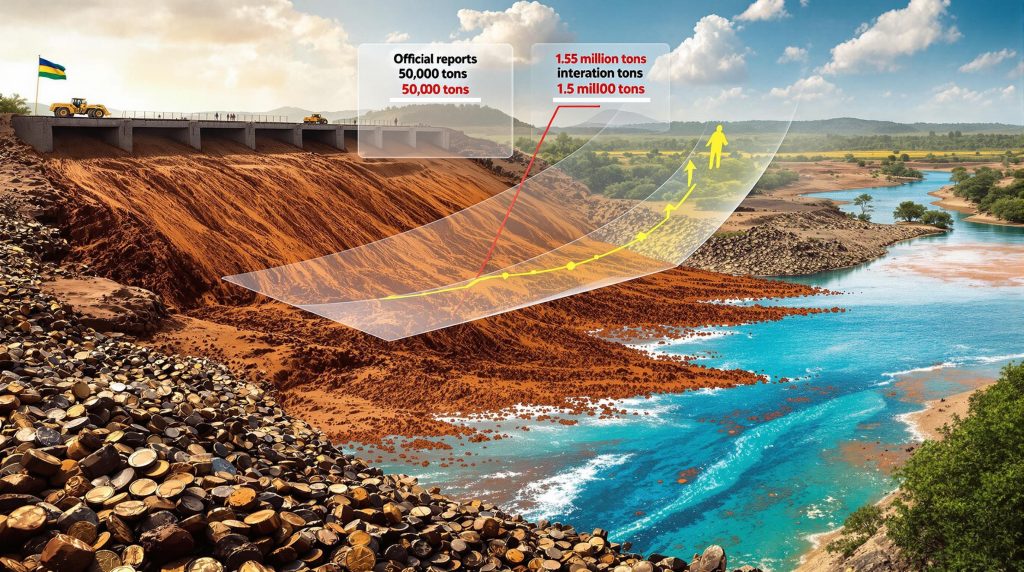Understanding the Zambian Mine Pollution Crisis: Environmental Impact and Government Response
The partial collapse of a waste dam at the Sino-Metals Leach copper mine in Zambia's Copperbelt Province has created ripple effects throughout the country's mining sector and raised serious questions about environmental oversight. What began as a seemingly contained incident has evolved into a significant environmental crisis with far-reaching implications for local communities, regulatory frameworks, and Zambia's ambitious copper production goals.
What Happened at the Chinese-Owned Copper Mine in Zambia?
The February 2025 Tailings Dam Failure
The crisis began in February 2025 when a tailings dam at the Sino-Metals Leach copper mine experienced a partial collapse. Initial official reports downplayed the severity, indicating approximately 50,000 tons of acidic mine waste had escaped containment. This assessment, however, proved dramatically understated.
An independent environmental audit conducted by Drizit Zambia Ltd. revealed a much more alarming picture: approximately 1.5 million tons of toxic sludge had actually been released—roughly 30 times larger than officially reported. To put this in perspective, the volume equates to approximately 400 Olympic swimming pools filled with acidic, metal-laden waste.
The discrepancy between official and independent assessments follows an unfortunate pattern seen in previous mining environmental controversies, where initial reports frequently underestimate damage scope and severity until independent verification occurs.
Immediate Environmental Consequences
The released waste contained highly acidic material with elevated concentrations of heavy metals, creating immediate contamination concerns for the Kafue River system—Zambia's longest river wholly contained within its borders. This waterway serves as a vital resource for drinking water, irrigation, and ecosystem support for countless communities downstream.
Environmental experts have identified several critical concerns following the toxic spill at China-owned Zambian mine:
- Soil contamination affecting agricultural productivity in a region where subsistence farming supports many local families
- Water quality degradation threatening both human consumption and aquatic ecosystems
- Heavy metal bioaccumulation in fish and other wildlife that serve as food sources
- Long-term persistent contamination as metals like copper, zinc, and manganese can remain in ecosystems for decades
The independent audit conducted by Drizit Zambia Ltd. described the incident as a "large-scale environmental catastrophe" and warned of "persisting serious health risks from heavy metals contained in the spill."
How Has the Zambian Government Responded to the Crisis?
Official Government Position
The Zambian government's response has drawn criticism for potentially downplaying the incident's severity. Environment Minister Mike Mposha publicly assured citizens that "water is fit for consumption" despite the massive tailings release.
Official laboratory tests showed pH acidity readings within safe levels in most sampled areas, with government officials acknowledging elevated readings for manganese and zinc in only 4 of 23 sampling locations. However, independent water quality experts note that:
- Heavy metal contamination often extends far beyond initial testing sites
- Contaminants can become concentrated in sediments rather than remaining suspended in water
- Single-point-in-time measurements may miss contamination pulses that occur during rainfall events
- Standard testing may not capture all potential contaminants present in complex mining waste
When questioned about the independent assessment that estimated the spill at 30 times the official volume, Minister Mposha declined to comment, stating it would be speculation as he had not "officially received any such report."
Previous government statements claimed the "immediate danger to human, animal and plant life has been averted," a position that contrasts sharply with the findings of environmental specialists who emphasize the long-term nature of such contamination events.
Regulatory Actions and Enforcement
The government's enforcement actions have raised questions about the adequacy of Zambia's environmental protection framework. Key actions taken include:
- Acceptance of an apology from Sino-Metals Leach
- Imposition of a fine totaling 1.5 million kwacha (approximately $65,000)—an amount many environmental advocates consider inadequate given the scale of the disaster
- Mandating a comprehensive environmental impact assessment, though the timeline and parameters remain undefined
- Oversight of initial compensation distribution to directly impacted farmers, though comprehensive damage assessments remain incomplete
In a surprising move, Sino-Metals terminated its contract with Drizit Zambia Ltd. after the firm's alarming findings contradicted official narratives. This action has raised transparency concerns among environmental watchdogs who emphasize the importance of independent verification in such incidents.
"When companies can simply dismiss environmental assessments they don't like, it undermines the entire regulatory framework designed to protect public health and natural resources," noted a prominent environmental advocate who requested anonymity due to ongoing litigation.
The relatively modest fine—$65,000 for a catastrophe affecting a major river system—highlights potential weaknesses in Zambia's environmental enforcement mechanisms. For context, similar incidents in countries with stronger regulatory frameworks have resulted in penalties in the hundreds of millions of dollars.
Why Are Tailings Dam Failures a Global Environmental Concern?
Recent History of Tailings Disasters
The Zambian incident joins a growing list of tailings failures that have focused international attention on mining waste management vulnerabilities. Most notably:
- The 2019 Brumadinho disaster in Brazil, where a Vale SA dam failure killed over 272 people and released 12 million cubic meters of iron ore tailings
- The 2014 Mount Polley mine disaster in Canada that released 24 million cubic meters of tailings slurry into nearby lakes and rivers
- The 2015 Samarco dam collapse in Brazil that killed 19 people and contaminated 650 kilometers of river systems
According to a comprehensive analysis published in the Journal of Sustainable Mining, there have been approximately 34 recorded major tailings dam failures globally between 2000 and 2019, with catastrophic consequences in most cases.
The mining industry faces heightened scrutiny over waste management practices, with investors, insurers, and regulators increasingly demanding adherence to more stringent standards. The Global Industry Standard on Tailings Management, developed after the Brumadinho disaster, represents the industry's attempt to address these concerns through improved design, monitoring, and emergency response protocols.
Environmental and Health Risks
The environmental and health risks associated with tailings failures extend far beyond immediate physical damage. Key concerns include:
- Heavy metal persistence: Contaminants like copper, lead, arsenic, and cadmium can remain in ecosystems for decades or even centuries
- Bioaccumulation: Toxic substances concentrate in the tissues of organisms and magnify up the food chain, potentially reaching dangerous levels in fish and wildlife consumed by humans
- Groundwater contamination: Heavy metals can infiltrate aquifers, creating long-term drinking water safety issues that are extremely difficult and expensive to remediate
- Soil contamination: Agricultural productivity can be severely impacted when toxic metals bind to soil particles, with some crops showing particular sensitivity to certain contaminants
- Ecosystem collapse: Aquatic ecosystems are especially vulnerable, with documented cases of fish populations crashing after exposure to mining waste
Environmental toxicologists emphasize that these impacts often manifest long after initial emergency response efforts conclude, creating what they term "silent disasters" that affect communities for generations.
What Are the Economic Implications for Zambia's Copper Industry?
Zambia's Copper Production Goals
Zambia ranks as Africa's second-largest copper producer, with production reaching approximately 788,000 metric tons in 2024. The government has established ambitious growth targets, aiming to more than triple output to 3 million tons by the early 2030s.
These expansion plans face several challenges:
- Balancing growth with environmental protection: Increased production inevitably generates more waste requiring proper management
- Infrastructure limitations: Many existing facilities, including tailings storage, were not designed for significantly increased throughput
- Community trust: Incidents like the toxic spill at China-owned Zambian mine erode public confidence in the industry's ability to operate responsibly
- Investment climate considerations: While Zambia needs foreign investment to achieve its production goals, environmental incidents can deter responsible investors
Copper represents approximately 70% of Zambia's total export earnings, making the sector's performance critical to the national economy. This economic dependency creates challenging dynamics when balancing enforcement against production incentives.
Regulatory and Reputational Challenges
The Sino-Metals incident has highlighted several regulatory and reputational challenges facing Zambia's mining sector:
- Oversight gaps: Questions about whether foreign-owned operations face the same scrutiny as domestic companies
- Enforcement adequacy: Whether current penalties provide sufficient deterrent against cutting environmental corners
- Transparency concerns: The significant discrepancy between official and independent assessments raises questions about information reliability
- Investment implications: Potential investors may hesitate to commit capital if regulatory frameworks appear inconsistent or unpredictable
International mining companies increasingly face pressure from shareholders, lenders, and insurers to demonstrate strong environmental, social, and governance (ESG) performance. Countries with robust and transparently enforced regulatory frameworks often prove more attractive for long-term investment despite potentially higher compliance costs.
How Does This Incident Compare to Other Mining Disasters?
Scale and Severity Assessment
While the estimated 1.5 million ton release represents a significant environmental incident, contextualizing its severity requires comparison with other major tailings failures:
| Incident | Year | Country | Material Released | Fatalities | Primary Contaminants |
|---|---|---|---|---|---|
| Sino-Metals | 2025 | Zambia | 1.5 million tons | 0 (reported) | Copper, zinc, manganese |
| Brumadinho | 2019 | Brazil | 12 million cubic meters | 272+ | Iron ore tailings |
| Mount Polley | 2014 | Canada | 24 million cubic meters | 0 | Copper, gold tailings |
| Samarco | 2015 | Brazil | 43 million cubic meters | 19 | Iron ore tailings |
The pattern of initial underreporting seen in the Zambian case mirrors experiences in previous disasters. After the Mount Polley incident, initial company estimates were later revised upward by over 40% as independent assessments were completed.
While the Zambian incident appears to have avoided immediate fatalities, environmental experts emphasize that the true impact may not be fully understood for years. Long-term monitoring will be essential to determine how heavy metals move through the ecosystem and potentially affect human health through contaminated water and food sources.
International Standards and Best Practices
The global mining industry has developed increasingly stringent tailings management protocols following high-profile failures. Key developments include:
- The Global Industry Standard on Tailings Management (GISTM), which establishes clear requirements for planning, design, construction, operation, and closure of tailings facilities
- Enhanced disclosure requirements from investors and insurers regarding tailings management practices
- Increased use of independent review boards to evaluate design and management practices
- Adoption of new technologies for continuous monitoring, including satellite-based deformation detection and real-time sensor networks
The Zambian incident underscores several principles emphasized in these frameworks:
- The critical importance of independent environmental monitoring
- The need for transparency in reporting incidents and their potential impacts
- The value of robust emergency response protocols that can be quickly activated
- The necessity of alignment with international standards rather than relying solely on local requirements
Mining companies operating to international standards typically employ multiple lines of defense against tailings failures, including conservative design parameters, regular third-party inspections, and sophisticated monitoring systems—practices that appear to have been inadequate at the Sino-Metals facility.
What Measures Are Needed to Prevent Future Tailings Dam Failures?
Engineering and Design Improvements
Modern tailings facility design has evolved significantly, with several approaches showing promise for reducing failure risks:
- Filtered tailings (dry stack): Removing water before disposal creates more stable waste deposits less susceptible to liquefaction
- Centerline or downstream construction: More conservative dam construction methods that provide greater stability than upstream designs
- Co-disposal with waste rock: Mixing tailings with waste rock can improve overall stability
- Paste backfill: Using thickened tailings as underground mine backfill reduces surface storage requirements
- Comprehensive monitoring systems: Real-time instrumentation that can detect subtle changes in dam behavior before failure occurs
These approaches generally require higher initial capital investment but significantly reduce long-term liability and failure risk. Mining engineers emphasize that proper design must be paired with rigorous construction quality control and ongoing maintenance.
Regulatory and Governance Solutions
Preventing future incidents requires strengthening several aspects of mining governance:
- Enhanced financial assurance requirements: Ensuring companies maintain sufficient resources for cleanup and remediation
- Independent third-party verification: Requiring regular inspections by qualified professionals not employed by the mining company
- Transparent public reporting: Making monitoring data and inspection reports available to affected communities
- Emergency preparedness: Developing and regularly testing response plans for potential failure scenarios
- Meaningful penalties: Ensuring fines and other consequences create genuine deterrence against negligence
The relatively small fine imposed on Sino-Metals ($65,000) highlights potential weaknesses in Zambia's enforcement framework. By comparison, the Mount Polley mine owner in Canada faced penalties exceeding $1.5 million, while Brazil's Vale agreed to a $7 billion settlement following the Brumadinho disaster.
Community engagement represents another critical element of effective governance. When local stakeholders participate in monitoring and have access to reliable information, they can serve as an early warning system for developing problems.
FAQ: Zambian Mine Pollution Incident
Is the water in affected areas safe to drink?
The Zambian government maintains that laboratory tests show pH levels within safe ranges in most areas. However, independent testing identified elevated levels of manganese and zinc in some locations. Given the discrepancies between official and independent assessments, residents in affected areas should:
- Follow the most conservative official health advisories
- Consider using alternative water sources where possible
- Watch for visual indicators of contamination (unusual color, odor, or taste)
- Remain alert for updated testing results as more comprehensive assessments are completed
It's important to note that heavy metal contamination often doesn't produce immediately noticeable water quality changes, making laboratory testing essential for safety verification.
What compensation has been provided to affected communities?
Sino-Metals has distributed initial compensation to farmers directly impacted by the spill, though specific amounts and distribution criteria remain poorly documented. Experience from similar incidents globally suggests compensation often occurs in phases:
- Emergency relief for immediate impacts
- Intermediate support during ongoing assessment
- Final settlements based on comprehensive damage evaluation
Communities should document all potential impacts, including:
- Crop losses
- Livestock health issues
- Water supply contamination
- Increased healthcare costs
- Property value diminishment
The adequacy of compensation will ultimately depend on whether long-term monitoring reveals persistent contamination requiring ongoing mitigation.
How will this incident affect Zambia's copper production targets?
While the government maintains its goal to triple copper production by the early 2030s, this incident may impact timelines and costs in several ways:
- Regulatory response: Possible strengthening of environmental requirements for new and existing operations
- Financing considerations: Potential increases in insurance costs and financial assurance requirements
- Community relations: Greater scrutiny and potential opposition to new project approvals
- Corporate risk assessment: Companies may apply more conservative design standards, increasing capital costs
The mining industry's experience in other regions suggests that major environmental incidents typically trigger regulatory responses that increase compliance costs but ultimately improve risk management and reduce liability.
What long-term environmental monitoring is planned?
A comprehensive impact assessment is reportedly planned following the termination of Drizit Zambia Ltd.'s initial contract. Based on best practices from similar incidents globally, effective monitoring should include:
- Surface water quality: Regular sampling throughout the affected watershed for at least 5-10 years
- Groundwater monitoring: Installation of monitoring wells to track potential aquifer contamination
- Soil testing: Periodic assessment of heavy metal levels in agricultural areas
- Biological monitoring: Tracking contaminant levels in fish, wildlife, and vegetation
- Sediment analysis: Evaluating metal accumulation in river and lake bottoms
Environmental scientists emphasize that monitoring programs must be designed with sufficient duration and scope to capture seasonal variations and potential long-term changes in contaminant mobility.
Key Statistics: Zambian Mine Pollution Incident
| Aspect | Official Report | Independent Assessment |
|---|---|---|
| Volume of toxic waste released | 50,000 tons | 1.5 million tons |
| Equivalent to Olympic swimming pools | ~13 pools | ~400 pools |
| Fine imposed on mining company | 1.5 million kwacha ($65,000) | N/A |
| Water sampling locations | 23 sites | Not specified |
| Sites with elevated heavy metals | 4 sites (manganese and zinc) | Not specified |
Preventing Future Tailings Dam Failures
The Zambian incident highlights the critical importance of proactive tailings management rather than reactive crisis response. Modern approaches to prevention incorporate multiple layers of protection:
Technological Solutions
Several technological innovations show promise for reducing tailings failure risks:
- Remote sensing and satellite monitoring: Regular deformation analysis using InSAR technology can detect subtle movements indicating potential instability
- Real-time instrumentation: Piezometers, inclinometers, and other sensors provide continuous data on dam conditions
Want to Capitalise on the Next Major ASX Mineral Discovery?
Stay ahead of the market with Discovery Alert's proprietary Discovery IQ model, which delivers instant notifications on significant ASX mineral discoveries, transforming complex data into actionable investment opportunities. Visit Discovery Alert's discoveries page to understand how major mineral discoveries have historically generated substantial returns for informed investors.




